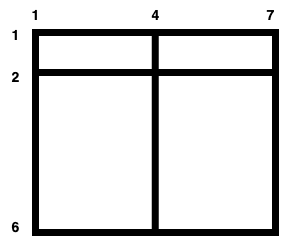| comments | difficulty | edit_url | rating | source | tags | |||
|---|---|---|---|---|---|---|---|---|
true |
Medium |
1873 |
Weekly Contest 377 Q2 |
|
There is a large (m - 1) x (n - 1) rectangular field with corners at (1, 1) and (m, n) containing some horizontal and vertical fences given in arrays hFences and vFences respectively.
Horizontal fences are from the coordinates (hFences[i], 1) to (hFences[i], n) and vertical fences are from the coordinates (1, vFences[i]) to (m, vFences[i]).
Return the maximum area of a square field that can be formed by removing some fences (possibly none) or -1 if it is impossible to make a square field.
Since the answer may be large, return it modulo 109 + 7.
Note: The field is surrounded by two horizontal fences from the coordinates (1, 1) to (1, n) and (m, 1) to (m, n) and two vertical fences from the coordinates (1, 1) to (m, 1) and (1, n) to (m, n). These fences cannot be removed.
Example 1:
Input: m = 4, n = 3, hFences = [2,3], vFences = [2] Output: 4 Explanation: Removing the horizontal fence at 2 and the vertical fence at 2 will give a square field of area 4.
Example 2:
Input: m = 6, n = 7, hFences = [2], vFences = [4] Output: -1 Explanation: It can be proved that there is no way to create a square field by removing fences.
Constraints:
3 <= m, n <= 1091 <= hFences.length, vFences.length <= 6001 < hFences[i] < m1 < vFences[i] < nhFencesandvFencesare unique.
We can enumerate any two horizontal fences
The time complexity is
class Solution:
def maximizeSquareArea(
self, m: int, n: int, hFences: List[int], vFences: List[int]
) -> int:
def f(nums: List[int], k: int) -> Set[int]:
nums.extend([1, k])
nums.sort()
return {b - a for a, b in combinations(nums, 2)}
mod = 10**9 + 7
hs = f(hFences, m)
vs = f(vFences, n)
ans = max(hs & vs, default=0)
return ans**2 % mod if ans else -1class Solution {
public int maximizeSquareArea(int m, int n, int[] hFences, int[] vFences) {
Set<Integer> hs = f(hFences, m);
Set<Integer> vs = f(vFences, n);
hs.retainAll(vs);
int ans = -1;
final int mod = (int) 1e9 + 7;
for (int x : hs) {
ans = Math.max(ans, x);
}
return ans > 0 ? (int) (1L * ans * ans % mod) : -1;
}
private Set<Integer> f(int[] nums, int k) {
int n = nums.length;
nums = Arrays.copyOf(nums, n + 2);
nums[n] = 1;
nums[n + 1] = k;
Arrays.sort(nums);
Set<Integer> s = new HashSet<>();
for (int i = 0; i < nums.length; ++i) {
for (int j = 0; j < i; ++j) {
s.add(nums[i] - nums[j]);
}
}
return s;
}
}class Solution {
public:
int maximizeSquareArea(int m, int n, vector<int>& hFences, vector<int>& vFences) {
auto f = [](vector<int>& nums, int k) {
nums.push_back(k);
nums.push_back(1);
sort(nums.begin(), nums.end());
unordered_set<int> s;
for (int i = 0; i < nums.size(); ++i) {
for (int j = 0; j < i; ++j) {
s.insert(nums[i] - nums[j]);
}
}
return s;
};
auto hs = f(hFences, m);
auto vs = f(vFences, n);
int ans = 0;
for (int h : hs) {
if (vs.count(h)) {
ans = max(ans, h);
}
}
const int mod = 1e9 + 7;
return ans > 0 ? 1LL * ans * ans % mod : -1;
}
};func maximizeSquareArea(m int, n int, hFences []int, vFences []int) int {
f := func(nums []int, k int) map[int]bool {
nums = append(nums, 1, k)
sort.Ints(nums)
s := map[int]bool{}
for i := 0; i < len(nums); i++ {
for j := 0; j < i; j++ {
s[nums[i]-nums[j]] = true
}
}
return s
}
hs := f(hFences, m)
vs := f(vFences, n)
ans := 0
for h := range hs {
if vs[h] {
ans = max(ans, h)
}
}
if ans > 0 {
return ans * ans % (1e9 + 7)
}
return -1
}function maximizeSquareArea(m: number, n: number, hFences: number[], vFences: number[]): number {
const f = (nums: number[], k: number): Set<number> => {
nums.push(1, k);
nums.sort((a, b) => a - b);
const s: Set<number> = new Set();
for (let i = 0; i < nums.length; ++i) {
for (let j = 0; j < i; ++j) {
s.add(nums[i] - nums[j]);
}
}
return s;
};
const hs = f(hFences, m);
const vs = f(vFences, n);
let ans = 0;
for (const h of hs) {
if (vs.has(h)) {
ans = Math.max(ans, h);
}
}
return ans ? Number(BigInt(ans) ** 2n % 1000000007n) : -1;
}
